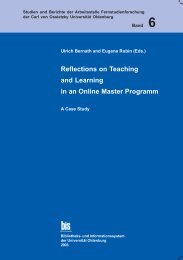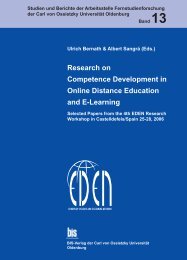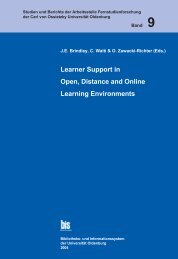Distance Education in Transition - Master of Distance Education ...
Distance Education in Transition - Master of Distance Education ...
Distance Education in Transition - Master of Distance Education ...
You also want an ePaper? Increase the reach of your titles
YUMPU automatically turns print PDFs into web optimized ePapers that Google loves.
A Pedagogical Model for Us<strong>in</strong>g Virtual Learn<strong>in</strong>g Spaces<br />
A. Learn<strong>in</strong>g by Expository Teach<strong>in</strong>g<br />
Traditional teach<strong>in</strong>g and learn<strong>in</strong>g behaviour <strong>in</strong> accordance with the "<strong>in</strong>struction paradigm"<br />
(cf. Re<strong>in</strong>mann-Rothmeier & Mandl, 1997a, p. 359) is, as we have stated, <strong>of</strong>ten transposed<br />
<strong>in</strong>to the virtual space. Oral and written texts are brought to the monitor with the<br />
pronounced gestures <strong>of</strong> presentation, whereby this is based on the models provided by<br />
lectures, talks, papers, distance teach<strong>in</strong>g courses, electronic courses, essays, monograph<br />
articles or entries <strong>in</strong> encyclopaedias (<strong>in</strong>struction space). This corresponds to the<br />
pronounced gesture <strong>of</strong> reception and absorption by the students, which is expressed for<br />
example <strong>in</strong> traditional lectures by busily tak<strong>in</strong>g notes, and <strong>in</strong> the digital learn<strong>in</strong>g<br />
environment by work<strong>in</strong>g through, copy<strong>in</strong>g and stor<strong>in</strong>g texts (documentation space).<br />
In some <strong>of</strong> these virtual spaces the effectiveness not only <strong>of</strong> presentational teach<strong>in</strong>g but<br />
also <strong>of</strong> absorptive learn<strong>in</strong>g behaviour can be <strong>in</strong>creased. We should bear <strong>in</strong> m<strong>in</strong>d the<br />
cumulat<strong>in</strong>g, <strong>in</strong>tensification and acceleration <strong>of</strong> presentation stimuli and modes (mulletmedia<br />
space) as well as the thoroughness, accuracy and clarity with which the presented<br />
teach<strong>in</strong>g is processed and graphically designed, and the speed with which it can be<br />
safely stored and accessed aga<strong>in</strong> and aga<strong>in</strong> for repeat<strong>in</strong>g teach<strong>in</strong>g and learn<strong>in</strong>g<br />
(documentation space). Here the student's memory enters <strong>in</strong>to an apparent symbiotic<br />
relationship with the computer's memory.<br />
But there is even more. If we <strong>in</strong>terpret such traditional learn<strong>in</strong>g as tend<strong>in</strong>g to be<br />
heterogamous, because most curricular and procedural decisions are taken by teachers,<br />
the digital learn<strong>in</strong>g environment appears to be able to perfect this traditional learn<strong>in</strong>g<br />
still further and to carry it to extremes. Presentations can be fixed step by step, and<br />
students "kept on a short lead" as it were (<strong>in</strong>struction space). The theoretical background<br />
for this form <strong>of</strong> teach<strong>in</strong>g and learn<strong>in</strong>g is provided by David P. Ausubel <strong>in</strong> his "theory <strong>of</strong><br />
expository teach<strong>in</strong>g" (1968) and his concept <strong>of</strong> "mean<strong>in</strong>gful receptive learn<strong>in</strong>g" (1980).<br />
An overlapp<strong>in</strong>g <strong>of</strong> expository teach<strong>in</strong>g and receptive learn<strong>in</strong>g takes place if "programmed<br />
<strong>in</strong>struction" (computer-based learn<strong>in</strong>g) is <strong>of</strong>fered <strong>in</strong> the digital learn<strong>in</strong>g environment.<br />
Students are led <strong>in</strong> very small steps from frame to frame, have to answer a test question<br />
on each frame and are provided with feedback on the success <strong>of</strong> their learn<strong>in</strong>g. Because<br />
these learn<strong>in</strong>g programmes were <strong>of</strong>fered <strong>in</strong>itially <strong>in</strong> pr<strong>in</strong>ted form, and then through the<br />
computer, it appeared obvious to many to regard the digital learn<strong>in</strong>g environment as the<br />
ideal place for their presentations. In fact, there is someth<strong>in</strong>g to be said for this, because<br />
programmes can be presented <strong>in</strong> a demand<strong>in</strong>g and impressive manner (multimedia space),<br />
a tutorial-type dialogue is possible with the s<strong>of</strong>tware (communications space) and<br />
branch<strong>in</strong>g <strong>of</strong>f is easier to manage. However, this form <strong>of</strong> teach<strong>in</strong>g and learn<strong>in</strong>g is <strong>in</strong><br />
practice <strong>of</strong>ten educationally underdeveloped. In the past it was criticised for this very<br />
reason (cf. Bates, 1995, p. 201). Often it is only useful for drill and practice. The versatile<br />
technological unit <strong>of</strong> the digital learn<strong>in</strong>g environment simply exercises the functions <strong>of</strong><br />
present<strong>in</strong>g and page turn<strong>in</strong>g (<strong>in</strong>struction space).<br />
Typically, the ambitious goal <strong>of</strong> programmers consists <strong>of</strong> us<strong>in</strong>g diagnostic tests,<br />
performance tests, <strong>in</strong>formation on results and selective repetition with <strong>in</strong>dividual<br />
learn<strong>in</strong>g times to br<strong>in</strong>g all (or nearly all) students to answer all the test questions,<br />
whereby the concept <strong>of</strong> mastery learn<strong>in</strong>g (Bloom, 1968) can be used as a guide. The<br />
dom<strong>in</strong>ation <strong>of</strong> teachers <strong>in</strong> the procedure cannot be exceeded. Students are turned <strong>in</strong> a<br />
behaviourist manner <strong>in</strong>to the objects <strong>of</strong> their teachers. The development <strong>of</strong> these<br />
92





